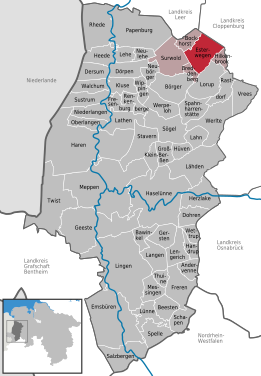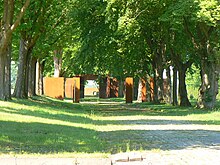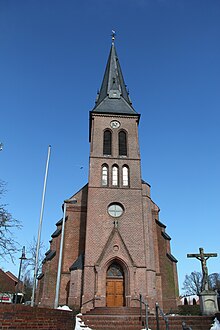Esterwegen
| coat of arms | Germany map | |
|---|---|---|

|
Coordinates: 53 ° 0 ' N , 7 ° 38' E |
|
| Basic data | ||
| State : | Lower Saxony | |
| County : | Emsland | |
| Joint municipality : | Northern humpback | |
| Height : | 13 m above sea level NHN | |
| Area : | 49.58 km 2 | |
| Residents: | 5429 (Dec. 31, 2019) | |
| Population density : | 109 inhabitants per km 2 | |
| Postal code : | 26897 | |
| Area code : | 05955 | |
| License plate : | Tbsp | |
| Community key : | 03 4 54 011 | |
| LOCODE : | DE 76Q | |
| Address of the municipal administration: |
Poststrasse 13 26897 Esterwegen |
|
| Website : | ||
| Mayor : | Hermann Willenborg ( UWGE ) | |
| Location of the municipality of Esterwegen in the district of Emsland | ||
Esterwegen is a municipality and the seat of the combined municipality Nordhümmling in the district of Emsland , which is located in western Lower Saxony in Germany .
The community with around 5,400 inhabitants stands out from the other communities of the free Hümmlings , as there was an estate in Esterwegen , so the farmers were not serfs , but were dependent on a landowner.
During the National Socialist era, the Esterwegen concentration camp was located on the site of the community . a. Carl von Ossietzky was interned for some time.
geography
location
Esterwegen is between Papenburg and Loeningen on a partially wooded to 39 meter high ridge of , the Esterweger bush . The village is surrounded by formerly extensive raised bogs in the northern part of the Hümmling region . A few kilometers to the south is the Hümmling hilly landscape.
Neighboring communities
Neighboring municipalities in the north are the municipality of Bockhorst, in the northeast the municipalities of Ostrhauderfehn in the district of Leer and the city of Friesoythe in the district of Cloppenburg , in the southeast the municipality of Hilkenbrook and the municipality of Lorup in the integrated municipality of Werlte , in the southwest the municipalities of Breddenberg and Surwold .
history
Meaning of the name
In Esterwegen , old form Hesterwede or Hesterwed around 1233, the basic word witu , wede , also later to wege or woe disfigured: wood in general, also scrub or tree, also dry wood. The defining word seems to contain an old word that often occurs in Nordic: hestr for horse, in Low German of the adjacent Frisian-Oldenburg language still preserved for foal, e.g. B. in the proverb: "He sprink as'n Haister". Esterwegen is therefore the name for undergrowth between which horses grazed.
Another explanation is based on “Heister-wede” for “Schößlingswald, Knüppelholzwald”. This is a forest in which young saplings are raised that were used by the local population.
First mention
Esterwegen was first mentioned in a document in 1223. Count Balduin von Bentheim gave his goods in Hesterwede (Esterwegen) to St. John for the salvation of his brothers and parents. The Order of St. John , based in Esterwegen , immediately founded a convent and started building the chapel, which was later destroyed. In 1227, Bishop Otto von Osnabrück agreed to donate the tithe to the newly founded Kommende .
15th and 16th centuries
In the 15th and 16th centuries, Esterwegen experienced a troubled history: at the instigation of Commander Heinrich von Hövel, Esterwegen changed ownership several times from 1574: to Margarethe Kottigk, Johannes Schultz, Heinrich von Hövel's son-in-law, and from 1589 to Amos Crumminga zu Loga and Weener. The Crummingas belonged to the most famous families of the Rheiderland at that time . It was a Herschopp family, some of whom were respected equally to the chiefs. Various disputes, lawsuits and even the use of Werlter riflemen followed, partly with the participation of the former Drosten des Emslandes, Hermann von Velen and the Hümmlingen judge Bernhard von Langen.
17th and 18th centuries
In 1625 the widow Crumminga offered Esterwegen to the Münster government for purchase. However, ownership fell partly through the marriage of the daughter Ida Juliana to Wilhelm Reinhard von Scheffert, known as Weisweiler, inheritance and purchase to the von Scheffert family. In 1671 Esterwegen was sold to the Hereditary Treasury Office of the Münster Monastery, founded in 1663 by Bishop Christoph Bernhard von Galen , and passed legally in 1677. At the same time, the right to jurisdiction over Esterwegen was transferred, including the death penalty. In addition to legal disputes in the 17th century, denominational and armed conflicts in the Thirty Years' War should also be mentioned. In 1738 there was a change of ownership from Franz Ferdinand von Scheffert to his daughter Bernhardine Franziska, fathered by his maid Adelheid Memering, a daughter of the Esterwegen hunter and armorer Memering zu Bockhorst, later to a "von Lixfeldt" through marriage to the princely Thurn and Taxis' Chief Postmaster Anselm von Lixfeldt. The Wüllenweber family then followed as owners in 1782, the Scheffert family again in 1808 and Josephine von Exterde in 1814.
19th century
On February 25, 1803, Esterwegen received the Reichsdeputationshauptschluss as the new sovereign Ludwig Engelbert von Arenberg. This was compensated for area losses left of the Rhine . As early as 1811, the whole of northwest Germany was incorporated into the French Empire . In 1815 it fell to the Kingdom of Hanover and in 1866 to the Kingdom of Prussia . The Duke of Arenberg was granted his civil status and the former Meppen office was divided into the four “glories”, highly autonomous areas, Aschendorf, Hümmling, Haselünne and Meppen. In 1837 Esterwegen was mentioned as a community. A census in 1885 revealed 240 residential buildings with 1002 people for Esterwegen with Bockhorst and Heidbrücken, of which 614 were men and 588 women. In 1837 a community leader was elected for the first time in accordance with the Hanover municipal constitution. In 1896/1897 the Catholic parish of the village built the church of St. John the Baptist.
The Esterwegen concentration camp and prison camp
In the summer of 1933, the Esterwegen concentration camp in Emsland was set up as one of the first concentration camps under National Socialist rule. It was one of a total of 15 Emsland camps . The camp was designed as a double camp (camps II and III) for 2,000 political “protective prisoners” and was temporarily the second largest concentration camp in the German Reich after Dachau . The Esterwegen concentration camp, which was headed by Emeran Schmid from 1935 , was dissolved in the summer of 1936. The camp continued to be used as a prison camp until 1945, in which political prisoners and night-and-fog prisoners were also imprisoned.
In the last days of the war the prison camp was severely overcrowded (there were 3000 prisoners for every 1000 places). During these days 170 of the prisoners were arbitrarily murdered by Willi Herold , the "executioner of the Emsland".
From 1945 until July 1947, Esterwegen served as an internment / prison camp for the British occupying forces. From 1953 to 1959 it was a refugee transit camp; all the former warehouse buildings were demolished. From 1963 to 2001, a Bundeswehr depot was operated on the storage area and the apron .
In 2011, a memorial for the entire complex of 15 Emsland camps and a monastery was set up on the site using depot buildings .
Population development
|
|
¹ as of December 31st
politics
Municipal council
The council of the Esterwegen community consists of 17 councilors. The local elections on September 11, 2016 brought the following results:
| Political party | Percent 2016 |
Seats 2016 |
Seats 2011 |
|---|---|---|---|
| CDU | 37.5 | 6th | 7th |
| UWG Esterwegen | 36.2 | 6th | 4th |
| SPD | 26.3 | 5 | 6th |
mayor
Hermann Willenborg (UWG Esterwegen) has been mayor of Esterwegen since 1996, and was confirmed in office in 2001, 2006, 2011 and 2016.
coat of arms
| Blazon : "A silver beech in red , the trunk of which is accompanied by a silver cross of St. John ." | |
| Reasons for the coat of arms: still open |
Culture and sights
Churches
- Catholic Church of St. Johannes Esterwegen
- Evangelical Lutheran Martin Luther Community Center
Museums and memorial
- Esterwegen memorial
- monastery
- Heimathaus Esterwegen
Natural monuments
- Moorland trail
recreation
- Recreation area Erikasee with youth tent, RV park and mini golf course.
Personalities
Sons and daughters of the church
- Heinrich Hanneken (1931–2018), Roman Catholic clergyman and canon of St. Peter's Cathedral in Osnabrück
literature
in order of appearance
- Hermann Abels: The place names of the Emsland, in their linguistic and cultural-historical significance. Ferdinand Schöningh Verlag, Paderborn 1929.
- Georg Ossenbühl: On the history of Esterwegen . In: Volkstum und Landschaft. Heimatblatt der Münsterländische Tageszeitung , vol. 31 (1969), no. 74, pp. 5-6.
- Albert Blüggel: Esterwegen yesterday and today . Hutters, Wickede (Ruhr) 1973.
- Werner Kaemling: Atlas on the history of Lower Saxony . Gerd-J.-Holtzmeyer-Verlag, Braunschweig 1987, ISBN 3-923722-44-3 .
- Bettina Schmidt-Czaia (Ed.): Esterwegen 1223 to 1999 - "Moor and heather only all around ...?" Esterwegen community, Esterwegen 1999, ISBN 3-00-004441-8 .
- Stefan Pötzsch: The Esterwegen estate. A knight's seat in the Nordhümmling . In: Our East Frisia. Supplement to Ostfriesen-Zeitung . Vol. 2008, No. 17, p. 67.
- Bianca Roitsch: Everyday togetherness and subsequent marginalization. The civil environment of the Esterwegen concentration and prison camp . In: Bernd Faulenbach , Andrea Kaltofen (Ed.): Hell in the Moor. The Emsland camps 1933–1945. Wallstein Verlag, Göttingen 2017, ISBN 978-3-8353-3137-2 , pp. 157-167.
Web links
Individual evidence
- ↑ State Office for Statistics Lower Saxony, LSN-Online regional database, Table 12411: Update of the population, as of December 31, 2019 ( help ).
- ^ Jürgen Udolph (research): The "place name researcher". In: website NDR 1 Lower Saxony . Archived from the original on December 3, 2016 ; accessed on August 4, 2019 .
- ↑ Helmut Jäger: From the Vicariate Foundation to the establishment of the parish. The chapel community Esterwegen . In: Bettina Schmidt-Czaia (Ed.): Esterwegen 1223 to 1999 - “Moor and heather only all around ...?” Esterwegen community, Esterwegen 1999, pp. 165–204.
- ↑ End of the Second World War: The executioner from Emsland. Retrieved on May 11, 2020 (German).
- ↑ a b c d Michael Rademacher: German administrative history from the unification of the empire in 1871 to the reunification in 1990. Aschendorf-Hümmling district ( see under: No. 13 ). (Online material for the dissertation, Osnabrück 2006).
- ^ Ulrich Schubert: Register of local authorities in Germany 1900 - Hümmling district. Information from December 1, 1910. In: gemeindeververzeichnis.de. February 3, 2019, accessed December 10, 2019 .
- ^ Federal Statistical Office (ed.): Official municipality directory for the Federal Republic of Germany . Final results according to the September 13, 1950 census. Volume 33 . W. Kohlhammer Verlag, Stuttgart / Cologne August 1952, p. 52 , col. 2 ( digital version [PDF; 26.4 MB ; accessed on December 10, 2019] District Aschendorf-Hümmling, p. 61).
- ↑ Lower Saxony State Administration Office (ed.): Municipal directory for Lower Saxony . Municipalities and municipality-free areas. Self-published, Hanover January 1, 1973, p. 49 , Aschendorf-Hümmling district ( digitized [PDF; 21.3 MB ; accessed on December 10, 2019]).
- ^ Municipalities in Germany by area and population. (XLSX; 895 kB) See under: Lower Saxony, No. 1948 . In: Destatis website. Federal Statistical Office, December 31, 1975, accessed on December 10, 2019 .
- ↑ a b c d e f g h i j Community directory - archive - regional structure - annual editions. (All politically independent municipalities in EXCEL format). In: Destatis website. Federal Statistical Office, accessed on December 10, 2019 .
- ↑ Esterwegen municipal election 2016 on 09/11/2016. ( Memento of the original from February 2, 2017 in the Internet Archive ) Info: The archive link was automatically inserted and not yet checked. Please check the original and archive link according to the instructions and then remove this notice. Samtgemeinde Nordhümmling, accessed on February 2, 2017.
- ↑ Mirco Moormann: Willenborg starts in Esterwegen in the fifth term. Neue Osnabrücker Zeitung , accessed on April 27, 2017.
- ↑ Main statutes of the Esterwegen community. (PDF; 58 kB) In: sg-nordhuemmling.de. July 17, 2012, accessed December 10, 2019 .
- ↑ Website of the moor info path





